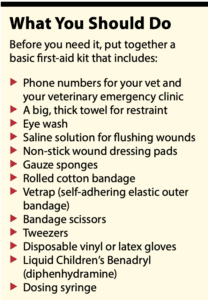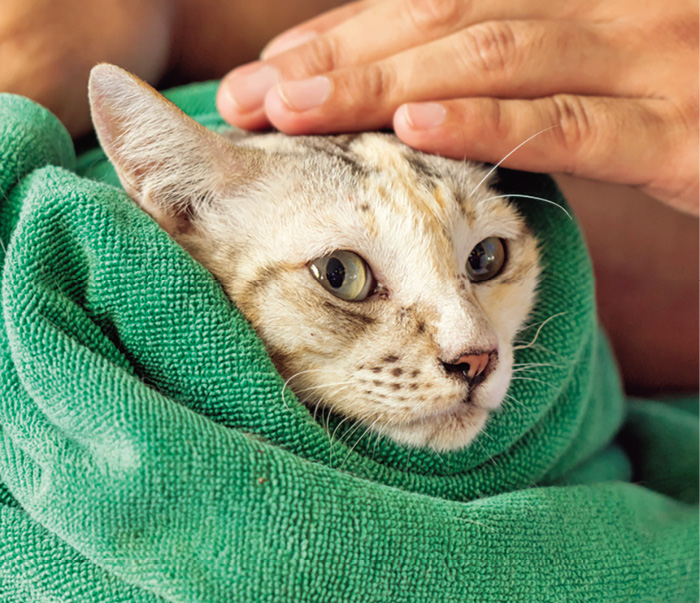Cats get into predicaments—we all know that—but sometimes they also get injured. While it may sound trivial when you’re worried about your kitty, the most important rule when rendering first-aid to an injured cat is for you to stay safe.
Traumatized cats often lash out viciously, whether from pain, stress, shock, or redirected aggression. Approach with caution. If possible, collect the cat with a thick towel or blanket so you can safely assess the cat’s reaction to being touched. If the cat reacts violently, it’s best not to struggle and risk further injury. Instead, try to place him in a safe travel container and get to the veterinarian.
If you can safely help the cat, use these immediate first-aid techniques to get the situation under control.
Bleeding
Apply direct pressure to stop the bleeding. If the bleeding is from a laceration, apply a loose bandage if you can and take the cat to the veterinarian.
Contaminated, Dirty Wound
Flush the wound with sterile saline solution, such as an eyewash solution. If it’s not available, use warm water. Remove any visible, easily removed matter with tweezers, then get to the vet. Some wounds may require suturing and antibiotics to prevent infection. The use of topical Neosporin is typically not recommended in cats, as anaphylactic reactions have been reported.
Ruptured Abscess
Outdoor cats frequently suffer from bite-wound abscesses that can quietly fester and then break open a week or so after the bite. If the injury is on an extremity, soaking in soapy warm water can help. Clean infected material from the area and get to the vet as soon as possible. Antibiotics are usually indicated.
Painful, Squinting Eye
Unless you can see visible foreign material, it’s best to leave this one to the vet. If you can see a splinter, seed, grass, dirt, or other foreign material, it’s OK to use an eye wash to try to flush the material out, but then get to the vet. Your cat could have a painful corneal ulcer caused by the foreign material.
Not Breathing, No Heartbeat
You can try CPR by rhythmically squeezing the cat’s lower chest between your thumb and index finger of one hand just behind the elbows or by using the palm of one hand with the fingers of both interwoven to provide chest compressions in this region.
You should press/squeeze firmly enough to compress the chest between 30% and 50% of its thickness, and shoot for a frequency of about 120 compressions/minute (compress to the rhythm of the song “Stayin’ Alive”). For every 30 compressions, extend the cat’s neck, close his mouth, and blow into the nostrils hard enough to see his chest rise and fall two times. And seek veterinary care immediately.
Other Emergencies
Some emergency situations are not due to trauma, but it’s worth knowing what to do in case you are faced with them.
Allergic Reactions
It’s hard to know if this is what’s happening, but if you happen to see your cat get stung by a bee or running away in distress from an ant hill or the like and you see signs of an allergic reaction, it’s usually OK to give a cat Benadryl by mouth. If possible, try to contact a veterinarian first.
Signs of an allergic reaction might include severe itching, coughing/wheezing/trouble breathing, or a painful, localized swelling. The dose of Benadryl is 1 milligram per 1 pound of body weight. If your cat’s breathing is labored, do not administer liquid medication by mouth and get to the veterinarian quickly.
Pyrethrin Poisoning
 This happens when someone mistakenly puts a topical dog flea/tick preventative on their cat. Signs of poisoning include drooling, vomiting, shaking, twitching, incoordination, agitation, seizures, and death. In this situation, before heading to the vet, it is worth very quickly bathing the cat with Dawn dishwashing liquid, focusing heavily on the spots where the product was applied. You can significantly decrease the amount of toxin your cat will continue to absorb by doing this. Then go to the vet! There are life-saving treatments for this toxicity if you get there in time.
This happens when someone mistakenly puts a topical dog flea/tick preventative on their cat. Signs of poisoning include drooling, vomiting, shaking, twitching, incoordination, agitation, seizures, and death. In this situation, before heading to the vet, it is worth very quickly bathing the cat with Dawn dishwashing liquid, focusing heavily on the spots where the product was applied. You can significantly decrease the amount of toxin your cat will continue to absorb by doing this. Then go to the vet! There are life-saving treatments for this toxicity if you get there in time.
Seizures
Keep the cat safe. Make sure he can’t fall, such as down a staircase or even off a chair. Gently wrap the cat in a blanket. Do not try to open his mouth. Use caution to avoid inadvertent injury to yourself. If the seizure stops within two minutes, you are probably OK to sit tight and monitor your kitty, but call your veterinarian promptly. If the seizure lasts longer than two minutes, go to the vet and call the office on the way.
Unfortunately, for many traumatic injuries, there is little you can do. Just stay calm, keep yourself safe; keep the cat calm, warm, and safely contained; and get to the vet as soon as possible.




